Numerical Modeling of Gas Migration and Hydrate Formation in Heterogeneous Marine Sediments
Abstract
1. Introduction
2. Geologic Setting
3. Numerical Modeling
3.1. Numerical Simulator
3.2. Model Set-Up
3.2.1. Concept Model and Boundary Conditions
3.2.2. Parameter Setting
3.2.3. Simulation Scenarios
4. Simulation Results
4.1. Homogeneous Base Model
4.2. Layered Heterogeneity of the Reservoir
4.3. Spatial Heterogeneity of the Reservoir
5. Discussion
5.1. Effect of Heterogeneous Sediments on Hydrate Storage Conditions
5.2. Effect of Heterogeneous Sediments on Gas Migration
5.3. Comparison with Field Observations
6. Conclusions
Author Contributions
Funding
Acknowledgments
Conflicts of Interest
References
- Milkov, A.V.; Sassen, R. Estimate of gas hydrate resource, northwestern Gulf of Mexico continental slope. Mar. Geol. 2001, 179, 71–83. [Google Scholar] [CrossRef]
- Luff, R.; Wallmann, K. Fluid flow, methane fluxes, carbonate precipitation and biogeochemical turnover in gas hydrate-bearing sediments at Hydrate Ridge, Cascadia Margin: Numerical modeling and mass balances. Geochim. Cosmochim. Acta 2003, 67, 3403–3421. [Google Scholar] [CrossRef]
- Zhang, G.; Huang, Y.; Zhu, Y.; Wu, B. Prospect of gas hydrate resources in the South China Sea. Mar. Geol. Quat. Geol. 2002, 22, 75–81. [Google Scholar]
- Zhang, G.; Chen, F.; Sha, Z.; Liang, J.; Su, X.; Lu, H. The geological evolution process of natural gas hydrate reservoirs in the northeastern South China Sea. Earth Sci. Front. 2017, 24, 15–23. [Google Scholar]
- Lin, C.; Lin, A.; Liu, C.; Chen, G.; Liao, Z.; Schnurle, P. Geological controls on BSR occurrences in the incipient arc-continent collision zone off southwest Taiwan. Mar. Pet. Geol. 2009, 26, 1118–1131. [Google Scholar] [CrossRef]
- Su, P.; Liang, J.; Fu, S.; Lü, W.; Gong, Y. Geological background and accumulation models of gas hydrate reservoir in northern South China Sea. Geol. China 2017, 44, 415–427. [Google Scholar]
- Davie, M.K.; Buffett, B.A. A numerical model for the formation of gas hydrate below the seafloor. J. Geophys. Res. Solid Earth 2001, 106, 497–514. [Google Scholar] [CrossRef]
- Hu, G.; Li, C.; Ye, Y.; Liu, C.; Zhang, J.; Diao, S. Observation of gas hydrate distribution in sediment pore space. Chin. J. Geophys. 2014, 57, 1675–1682. [Google Scholar]
- Chen, Q.; Liu, C.; Xing, L.; Hu, G.; Meng, Q.; Sun, J.; Jin, X. Resistivity variation during hydrate formation in vertical in homogeneous distribution system of pore water. Acta Pet. Sin. 2016, 37, 222–229. [Google Scholar]
- Li, C.; Hu, G.; Zhang, W.; Ye, Y.; Liu, C.; Li, Q.; Sun, J. Influence of foraminifera on formation and occurrence characteristics of natural gas hydrates in fine-grained sediments from Shenhu area, South China Sea. Sci. China Earth Sci. 2016, 59, 2223–2230. [Google Scholar] [CrossRef]
- Grevemeyer, I.; Villinger, H. Gas hydrate stability and the assessment of heat flow through continental margins. Geophys. J. Int. 2001, 145, 647–660. [Google Scholar] [CrossRef]
- Liang, J.; Wang, H.; Su, X.; Fu, S.; Wang, L.; Guo, Y.; Chen, F.; Shang, J. Natural gas hydrate formation conditions and the associated controlling factors in the northern slope of the South China Sea. Nat. Gas Ind. 2014, 34, 128–135. [Google Scholar]
- Su, Z.; Cao, Y.; Yang, R.; Wu, N.; Yang, S.; Wang, H. Analytical research on evolution of methane hydrate deposits at Shenhu Area, northern South China Sea. Chin. J. Geophys. 2012, 55, 1764–1774. [Google Scholar]
- Su, M.; Sha, Z.; Zhang, C.; Wang, H.; Wu, N.; Yang, R.; Liang, J.; Qiao, S.; Cong, X.; Liu, J. Types, Characteristics and Significances of Migrating Pathways of Gas-bearing Fluids in the Shenhu Area, Northern Continental Slope of the South China Sea. Acta Geol. Sin. Engl. Ed. 2017, 91, 219–231. [Google Scholar] [CrossRef]
- Guo, Y.; Yang, S.; Liang, J.; Lu, J.; Lin, L.; Kuang, Z. Characteristics of high gas hydrate distribution in the Shenhu Area on the northern slope of the South China Sea. Earth Sci. Front. 2017, 24, 24–31. [Google Scholar]
- Yang, S.; Liang, J.; Lu, J.; Qu, C.; Liu, B. New understandings on the characteristics and controlling factors of gas hydrate reservoirs in the Shenhu area on the northern slope of the South China Sea. Earth Sci. Front. 2017, 24, 1–14. [Google Scholar]
- Wang, J.; Liang, J.; Zong, X.; Gong, Y.; Wan, T. Differentiated distribution of methane hydrate in the Shenhu Area of the northern South China Sea and controlling factors. Mar. Geol. Front. 2015, 31, 24–30. [Google Scholar]
- Zhang, H.; Lu, H.; Liang, J.; Wu, N. The methane hydrate accumulation controlled compellingly by sediment grain at Shenhu, northern South China Sea. Chin. Sci. Bull. 2016, 61, 388–397. [Google Scholar] [CrossRef]
- Malinverno, A. Marine gas hydrates in thin sand layers that soak up microbial methane. Earth Planet. Sci. Lett. 2010, 292, 399–408. [Google Scholar] [CrossRef]
- Chatterjee, S.; Bhatnagar, G.; Dugan, B.; Dickens, G.; Chapman, W.; Hirasaki, G. The impact of lithologic heterogeneity and focused fluid flow upon gas hydrate distribution in marine sediments. J. Geophys. Res. Solid Earth 2014, 119, 6705–6732. [Google Scholar] [CrossRef]
- Nole, M.; Daigle, H.; Cook, A.E.; Malinverno, A. Short-range, overpressure-driven methane migration in coarse-grained gas hydrate reservoirs. Geophys. Res. Lett. 2016, 43, 9500–9508. [Google Scholar] [CrossRef]
- Li, S.; Chu, F.; Fang, Y.; Wu, Z. Associated interpretation of sub-bottom and single-channel seismic profiles from slope of Shenhu Area in the northern South China Sea—Characteristics of gas hydrate sediment. J. Trop. Oceanogr. 2010, 29, 56–62. [Google Scholar]
- He, L.; Lei, X.; Zhang, Y. Numerical modeling of gas hydrate accumulation in the marine sediments of Shenhu area, northern South China Sea. Chin. J. Geophys. 2011, 54, 299–306. [Google Scholar] [CrossRef]
- Zhang, Y.; He, L.; Wang, J.; Xu, X.; Sha, Z.; Gong, Y.; Wang, H.; Liang, J. Heat flow pattern, base of methane hydrates stability zones and BSRs in Shenhu Area, northern South China Sea. Acta Oceanol. Sin. 2011, 30, 59–67. [Google Scholar] [CrossRef]
- Wu, N.; Zhang, H.; Yang, S.; Liang, J.; Wang, H.; Su, X.; Lu, Z.; Fu, S.; Zhang, G.; Lu, J. Preliminary discussion on natural gas hydrate (NGH) reservoir system of Shenhu Area, north slope of South China Sea. Nat. Gas Ind. 2007, 27, 1–6. [Google Scholar]
- He, J.; Yan, W.; Zhu, Y.; Zhang, W.; Gong, F.; Zhang, S.; Zhang, J.; Gong, X. Bio-genetic and sub-biogenetic gas resource potential and genetic types of natural gas hydrates in the northern marginal basins of South China Sea. Nat. Gas Ind. 2013, 33, 121–134. [Google Scholar]
- Zhu, Q.; Wu, Q.; Wu, X.; He, L.; Hou, Z. A comparative study on gas hydrate accumulations in Shenhu area and Xisha trough. Marine Geol. Front. 2017, 33, 55–62. [Google Scholar]
- Wang, J.; Wu, S.; Kong, X.; Li, Q.; Wang, J.; Ding, R. Geophysical characterization of a fine-grained gas hydrate reservoir in the Shenhu area, northern South China Sea: Integration of seismic data and downhole logs. Mar. Pet. Geol. 2018, 92, 895–903. [Google Scholar] [CrossRef]
- Yang, S.; Zhang, M.; Liang, J.; Lu, J.; Lu, J.; Zhang, Z.; Melanie, H.; Peter, S.; Fu, S.; Sha, Z. Preliminary results of China’s Third Gas Hydrate Drilling Expedition: A critical step from discovery to development in the South China Sea: Fire in the Ice. Cent. Nat. Gas Oil 2015, 412, 386–7614. [Google Scholar]
- Wang, X.; Collett, T.; Lee, M.; Yang, S.; Guo, Y.; Wu, S. Geological controls on the occurrence of gas hydrate from core, downhole log, and seismic data in the Shenhu area, South China Sea. Mar. Geol. 2014, 357, 272–292. [Google Scholar] [CrossRef]
- Moridis, G.J.; Reagan, M.T. Estimating the upper limit of gas production from Class 2 hydrate accumulations in the permafrost: 2. Alternative well designs and sensitivity analysis. J. Pet. Sci. Eng. 2011, 76, 124–137. [Google Scholar] [CrossRef]
- Moridis, G.J. User’s Manual for the Hydrate v1. 5 Option of TOUGH+ v1. 5: A Code for the Simulation of System Behavior in Hydrate-Bearing Geologic Media. Available online: https://www.osti.gov/servlets/purl/1165986 (accessed on 1 November 2014).
- Jin, G.; Xu, T.; Xin, X.; Wei, M.; Liu, C. Numerical evaluation of the methane production from unconfined gas hydrate-bearing sediment by thermal stimulation and depressurization in Shenhu area, South China Sea. J. Nat. Gas Sci. Eng. 2016, 33, 497–508. [Google Scholar] [CrossRef]
- Sun, J.; Zhang, L.; Ning, F.; Lei, H.; Liu, T.; Hu, G.; Lu, H.; Lu, J.; Liu, C.; Jiang, G.; et al. Production potential and stability of hydrate-bearing sediments at the site GMGS3-W19 in the South China Sea: A preliminary feasibility study. Mar. Pet. Geol. 2017, 86, 447–473. [Google Scholar] [CrossRef]
- Wan, Y.; Wu, N.; Hu, G.; Xin, X.; Guang, R.; Liu, C.; Chen, Q. Reservoir stability in the process of natural gas hydrate production by depressurization in the Shenhu area of the South China Sea. Nat. Gas Ind. 2018, 4, 117–128. [Google Scholar] [CrossRef]
- Rutqvist, J.; Moridis, G.J. Numerical Studies on the Geomechanical Stability of Hydrate-Bearing Sediments. SPE J. 2009, 14, 267–282. [Google Scholar] [CrossRef]
- Van Genuchten, M.T. A closed-form equation for predicting the hydraulic conductivity of unsaturated soils 1. Soil Sci. Soc. Am. J. 1980, 44, 892–898. [Google Scholar] [CrossRef]
- Moridis, G.J.; Seol, Y.; Kneafsey, T.J. Studies of Reaction Kinetics of Methane Hydrate Dissocation in Porous Media. In Proceedings of the Fifth International Conference on Gas Hydrates, Berkeley, CA, USA, 10 March 2005; pp. 21–30. [Google Scholar]
- Moridis, G.J. TOUGH+ HYDRATE v1. 2 User’s Manual: A Code for the Simulation of System Behavior in Hydrate-Bearing Geologic Media. Available online: https://www.osti.gov/servlets/purl/1173164 (accessed on 4 April 2014).
- Zhang, K.; Moridis, G.; Wu, N.; Li, X.; Reagan, M. Evaluation of alternative horizontal well designs for gas production from hydrate deposits in the Shenhu Area, South China Sea. In Proceedings of the International Oil and Gas Conference and Exhibition in China, Society of Petroleum Engineers, Beijing, China, 8–10 June 2010. [Google Scholar]
- Yuan, Y.; Xu, T.; Xin, X.; Xia, Y. Multiphase Flow Behavior of Layered Methane Hydrate Reservoir Induced by Gas Production. Geofluids. 2017, 2017. [Google Scholar] [CrossRef]
- Zhu, H.; Xu, T.; Feng, G.; Yuan, Y.; Jiang, Z. Numerical modeling of the performance of the CO2-plume geothermal system in a permeability and porosity heterogeneous reservoir. Acta Energ. Sol. Sin. 2017, 38, 1814–1821. [Google Scholar]
- Nelson, P.H. Permeability-Porosity Relationships in Sedimentary Rocks; The log analyst; Society of Petrophysicists and Well-Log Analysts: Houston, TX, USA, 1994; p. 35. [Google Scholar]
- Tian, H.L.; Pan, F.; Xu, T.F.; McPherson, B.J.; Yue, G.F.; Mandalaparty, P. Impacts of hydrological heterogeneities on caprock mineral alteration and containment of CO2 in geological storage sites. Int. J. Greenh. Gas Control 2014, 24, 30–42. [Google Scholar] [CrossRef]
- Fujii, T.; Suzuki, K.; Takayama, T.; Tamaki, M.; Komatsu, Y.; Konno, Y.; Yoneda, J.; Yamamoto, K.; Nagao, J. Geological setting and characterization of a methane hydrate reservoir distributed at the first offshore production test site on the Daini-Atsumi Knoll in the eastern Nankai Trough, Japan. Mar. Pet. Geol. 2015, 66, 310–322. [Google Scholar] [CrossRef]
- Cook, A.E.; Goldberg, D. Extent of gas hydrate filled fracture planes: Implications for in situ methanogenesis and resource potential. Geophys. Res. Lett. 2008, 35, 1–5. [Google Scholar] [CrossRef]
- Lee, M.W.; Collett, T.S. Gas hydrate saturations estimated from fractured reservoir at Site NGHP-01-10, Krishna-Godavari Basin, India. J. Geophys. Res. Solid Earth 2009. [Google Scholar] [CrossRef]
- Kim, G.; Narantsetseg, B.; Ryu, B.; Yoo, D.; Lee, J.; Kim, H.; Riedel, M. Fracture orientation and induced anisotropy of gas hydrate-bearing sediments in seismic chimney-like-structures of the Ulleung Basin, East Sea. Mar. Pet. Geol. 2013, 47, 182–194. [Google Scholar] [CrossRef]
- Chen, F.; Su, X.; Zhou, Y.; Lu, H.; Liu, G.; Chen, Z.; Chen, C. Variations in biogenic components of late Miocene-Holocene sediments from Shenhu area in the northern South China Sea and their geological implication. Mar. Geol. Quat. Geol. 2009, 29, 1–8. [Google Scholar]
- Zhang, W.; Liang, J.; Lu, J.; Yu, J.; Su, P.; Fang, Y.; Guo, Y.; Yang, S.; Zhang, G. Accumulation features and mechanisms of high saturation natural gas hydrate in Shenhu Area, northern South China Sea. Pet. Explor. Dev. 2017, 44, 708–719. [Google Scholar] [CrossRef]
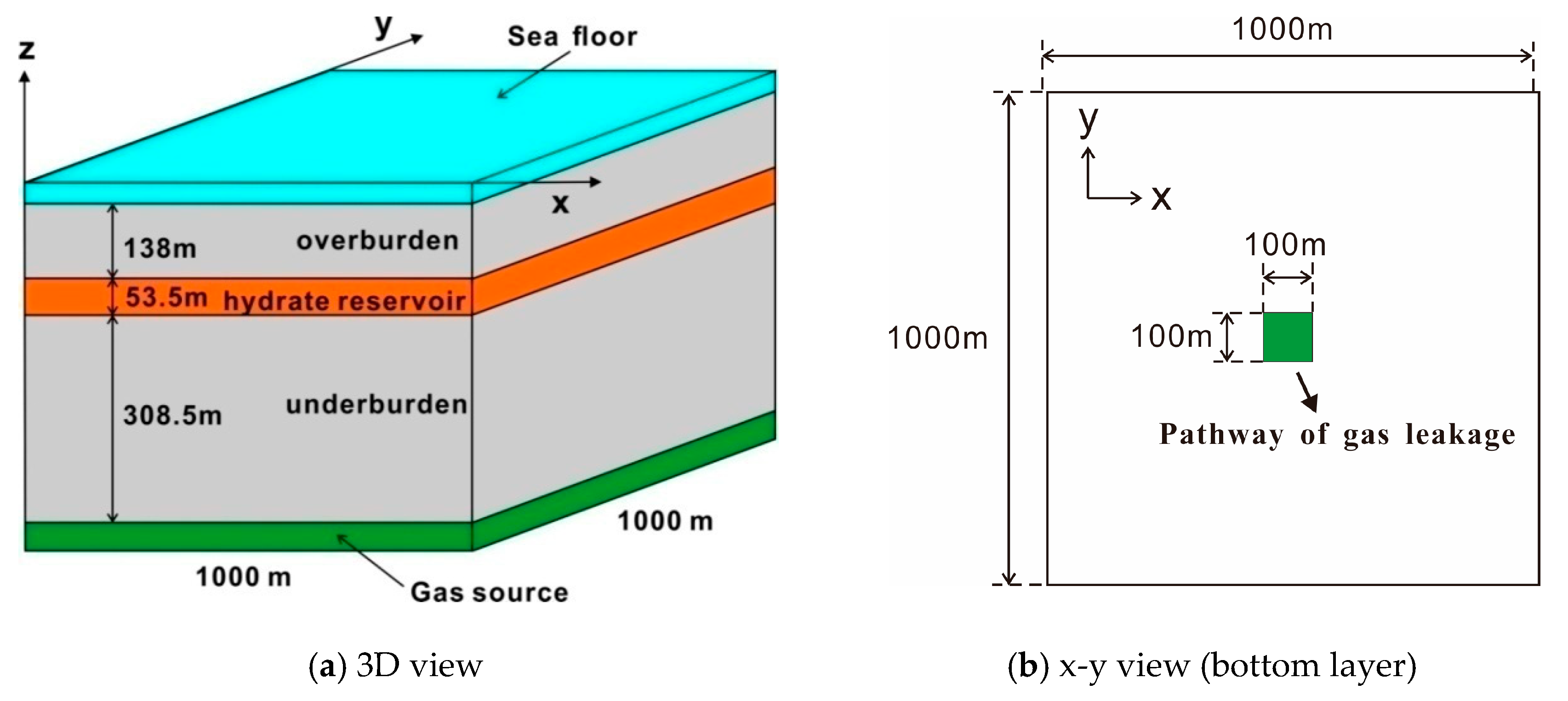

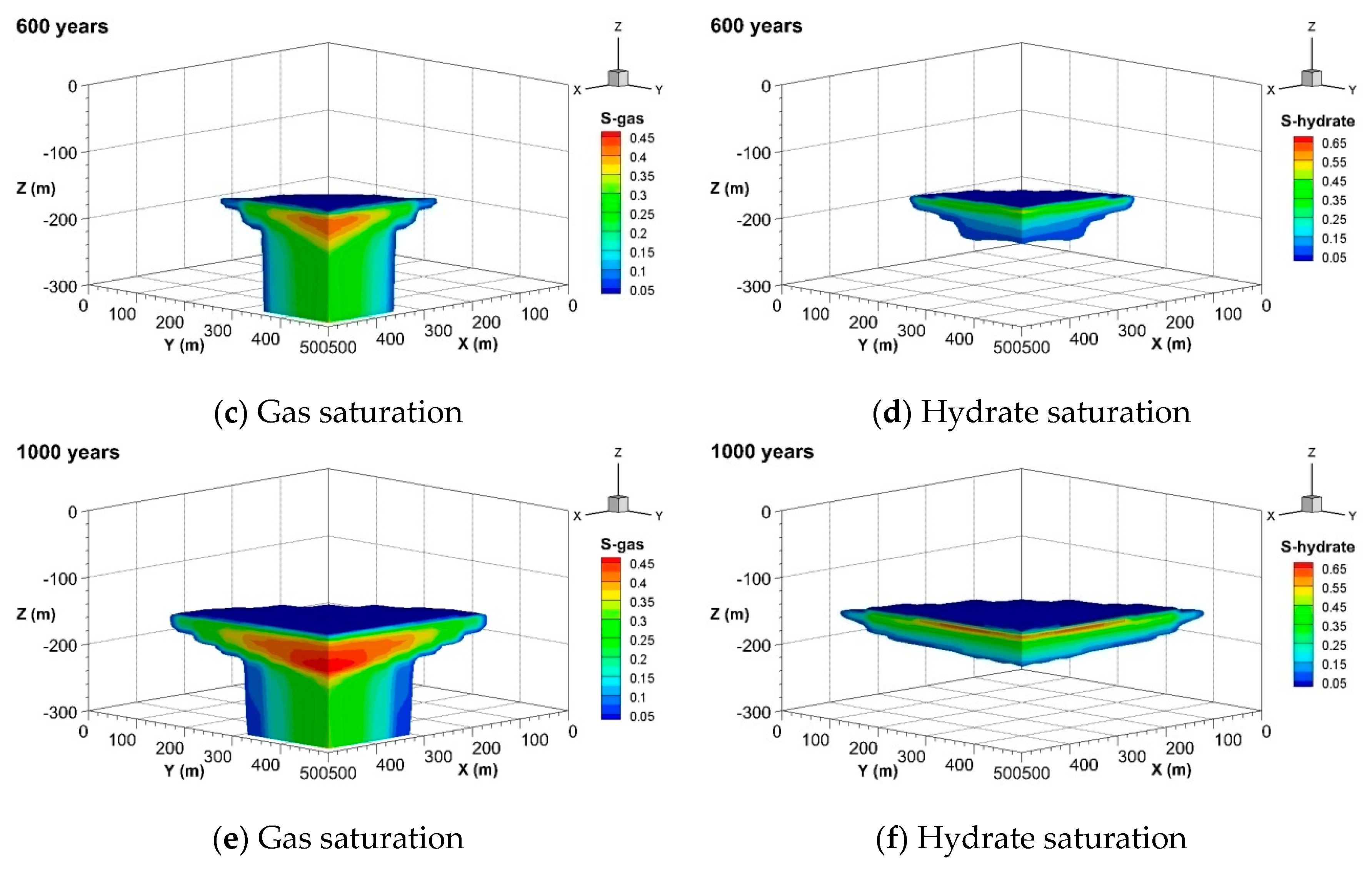
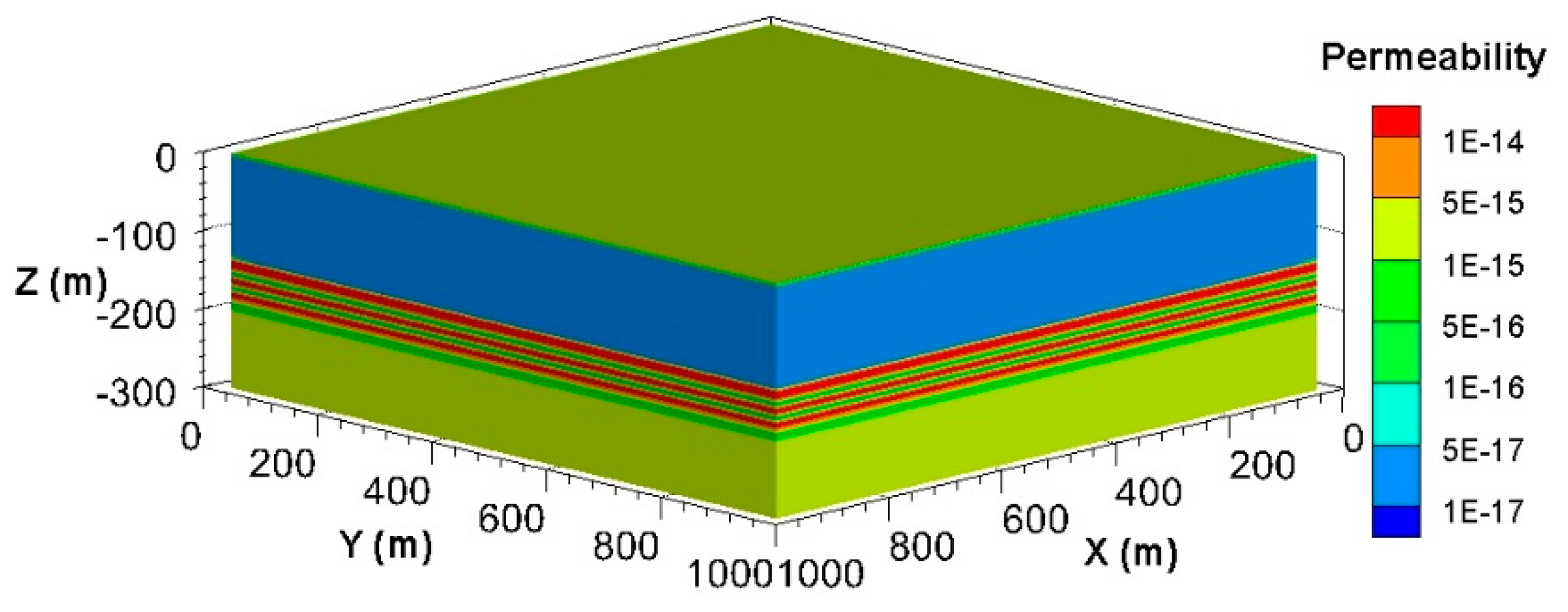
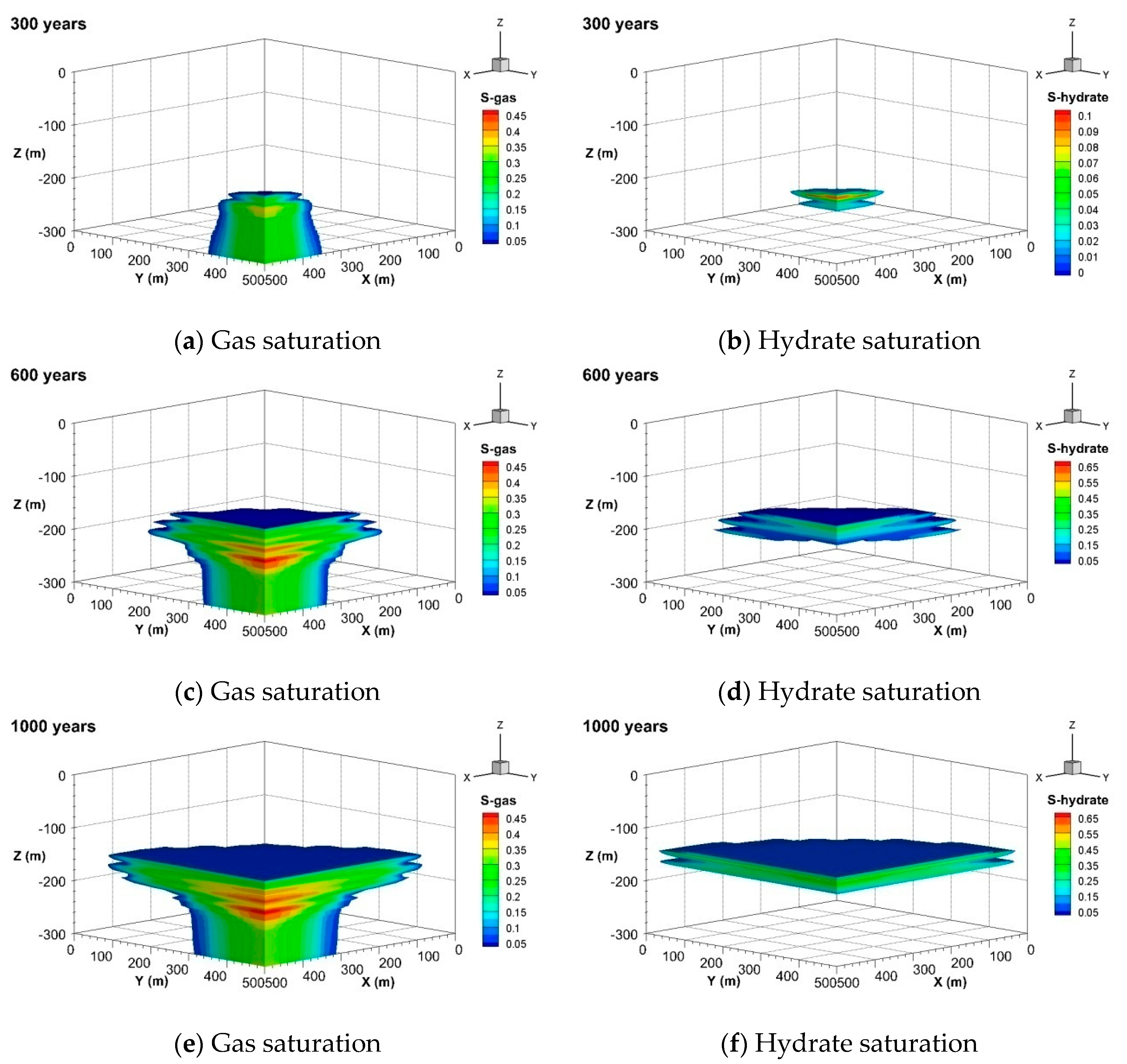
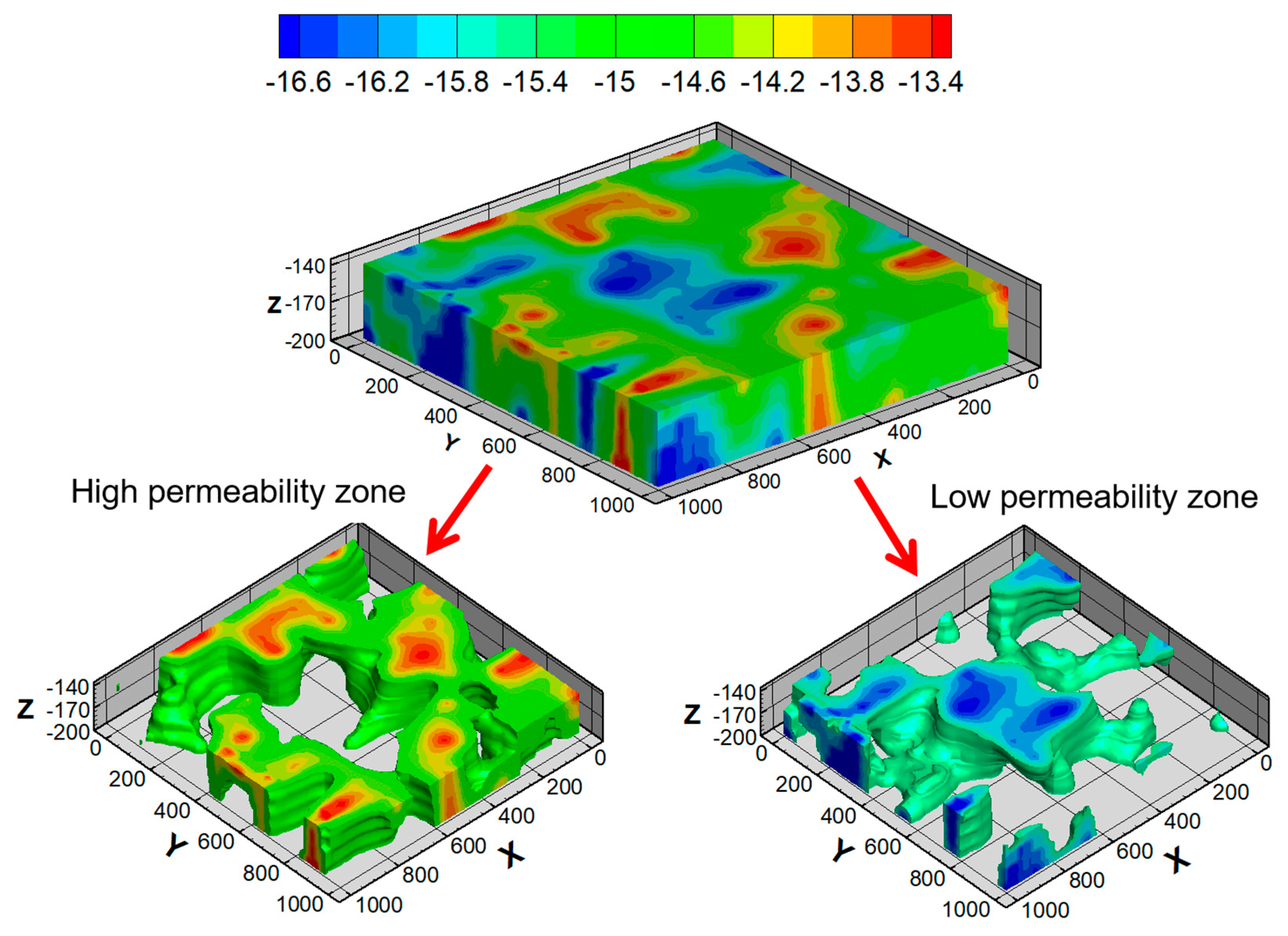
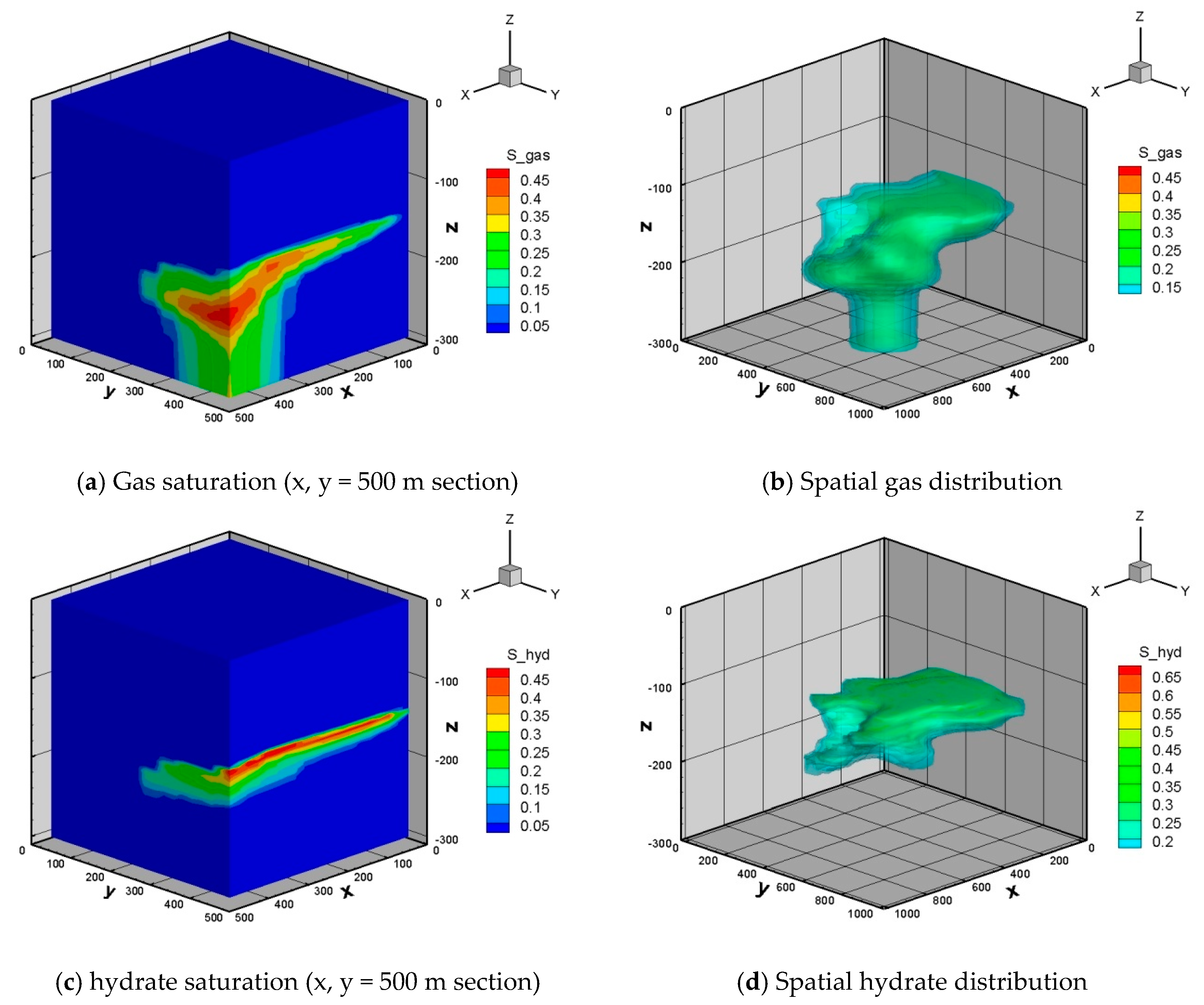

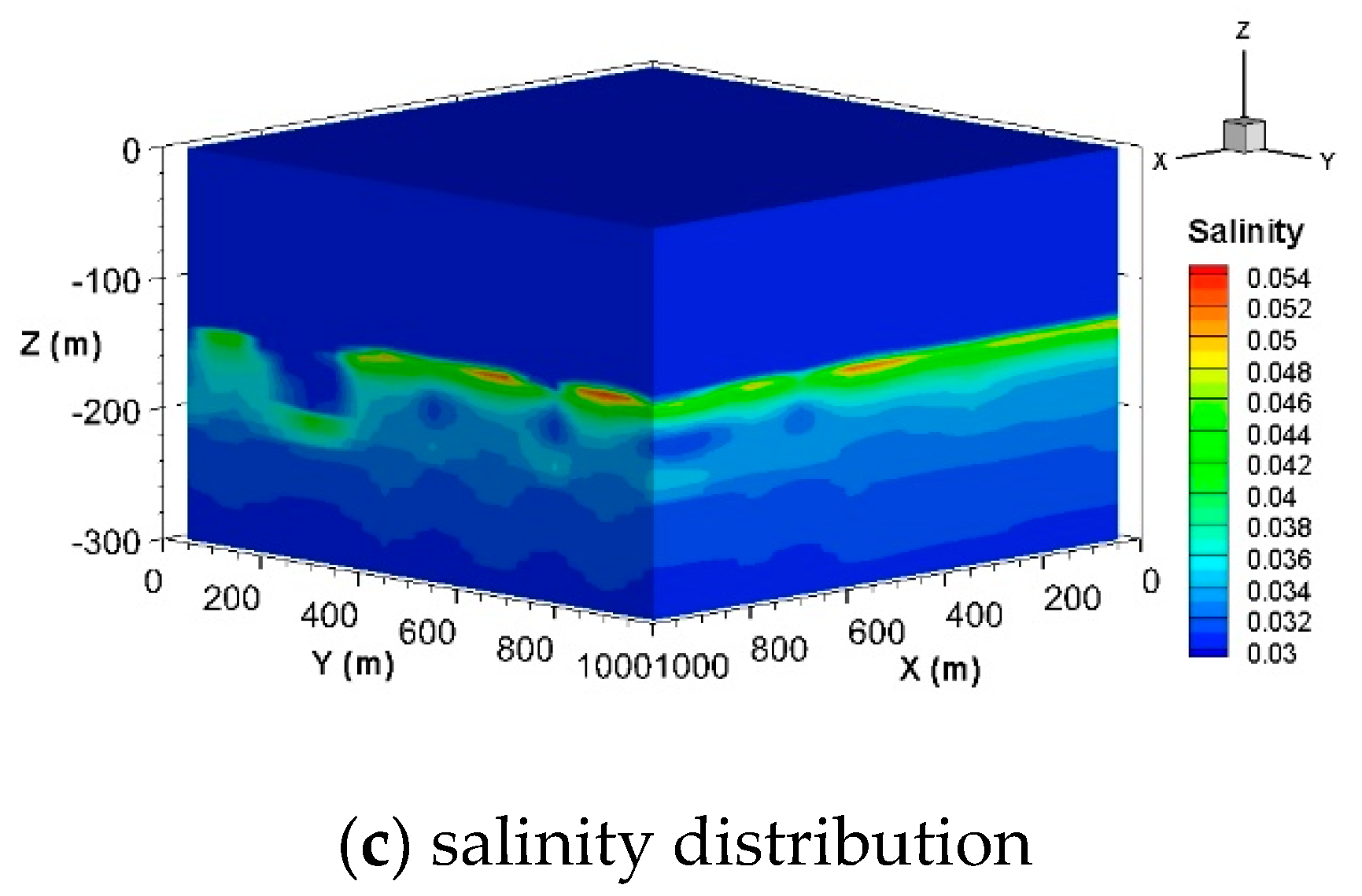

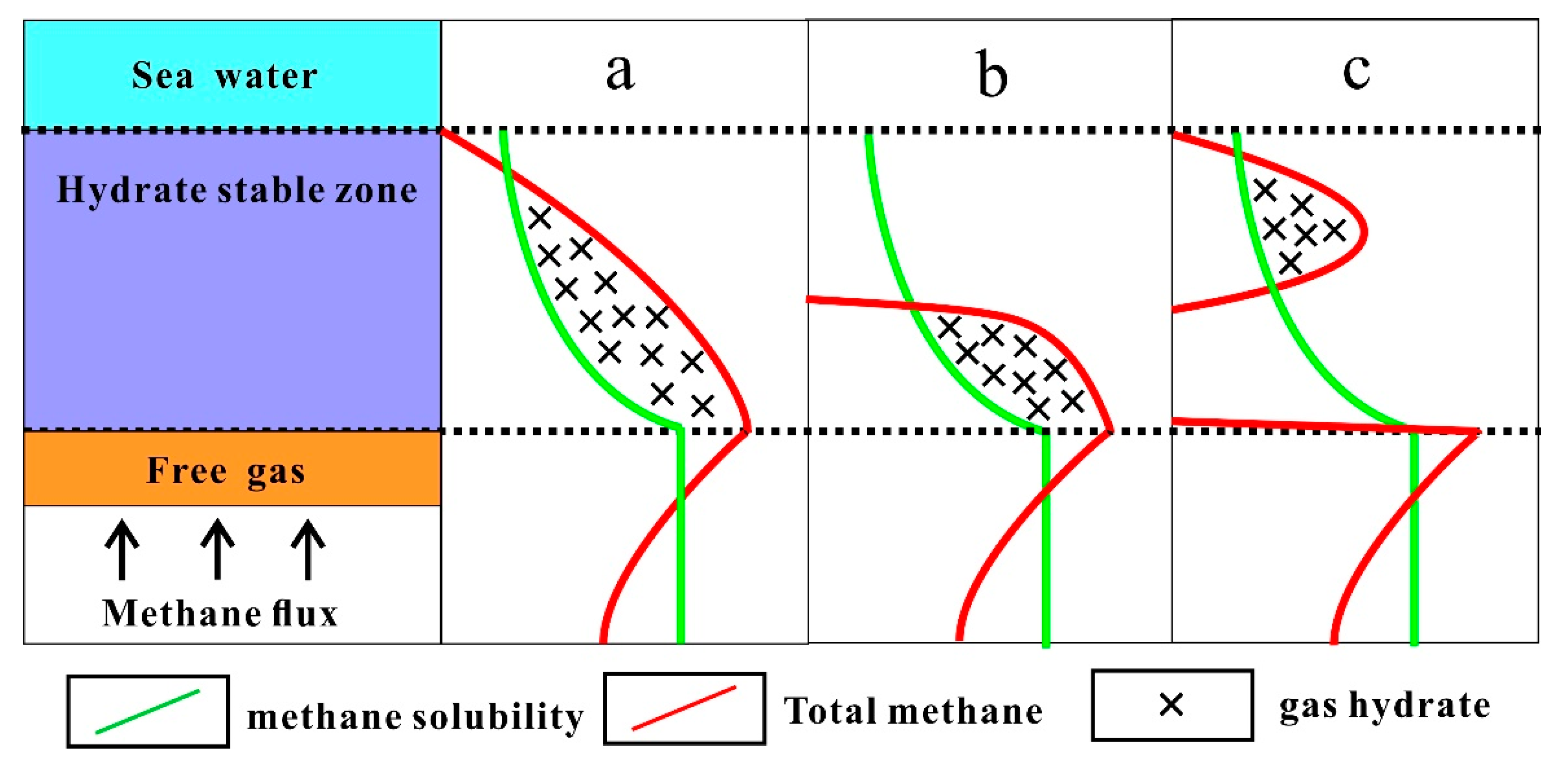
| Parameter | Value | Source |
|---|---|---|
| Upper boundary temperature | 3.75 °C | [35] |
| Upper boundary pressure | 12.86 MPa | [35] |
| Temperature gradient | 0.045 °C/m | [35] |
| Rock grain density | 2600 kg/m3 | [40] |
| Rock grain specific heat | 1.0 KJ/(kg·K) | [33] |
| Water salinity | 3.05% | [34] |
| Hydrate density | 920.0 kg/m3 | [33] |
| Hydrate specific heat | 2.1 KJ/(kg·K) | [33] |
| Pore compressibility | 1.0 × 10−9 Pa−1 | [40] |
| Dry thermal conductivity () | 1.00 W/(m·K) | [41] |
| Wet thermal conductivity () | 3.10 W/(m·K) | [41] |
| Intrinsic permeability () | 1.16 mD (1 mD = 1.0 × 10−15 m2) | [34] |
| Porosity () | 0.424 | [34] |
| Irreducible aqueous saturation () | 0.30 | [40] |
| Index for the aqueous phase () | 5.0 | [40] |
| Irreducible gas saturation () | 0.03 | [40] |
| Index for the gas phase () | 3.5 | [40] |
| The entry capillary pressure () | 1.0 × 105 Pa | [40] |
| Index for the pore structure (m) | 0.45 | [40] |
| Critical mobile phase saturation () | 0.05 | [33] |
| Permeability reduction exponent (n) | 3.0 | [33] |
| Case Name | Conditions of the Hydrate Reservoir | Intrinsic Permeability/m2 |
|---|---|---|
| Base-case | homogeneity | 1.16 × 10−15 |
| Case 1 | layered heterogeneity | high permeability layer: 1.16 × 10−14 low permeability layer: 1.16 × 10−16 |
| Case 2 | spatial heterogeneity | 1.16 × 10−13–1.16 × 10−17 |
© 2019 by the authors. Licensee MDPI, Basel, Switzerland. This article is an open access article distributed under the terms and conditions of the Creative Commons Attribution (CC BY) license (http://creativecommons.org/licenses/by/4.0/).
Share and Cite
Bei, K.; Xu, T.; Shang, S.; Wei, Z.; Yuan, Y.; Tian, H. Numerical Modeling of Gas Migration and Hydrate Formation in Heterogeneous Marine Sediments. J. Mar. Sci. Eng. 2019, 7, 348. https://doi.org/10.3390/jmse7100348
Bei K, Xu T, Shang S, Wei Z, Yuan Y, Tian H. Numerical Modeling of Gas Migration and Hydrate Formation in Heterogeneous Marine Sediments. Journal of Marine Science and Engineering. 2019; 7(10):348. https://doi.org/10.3390/jmse7100348
Chicago/Turabian StyleBei, Keqi, Tianfu Xu, Songhua Shang, Zilin Wei, Yilong Yuan, and Hailong Tian. 2019. "Numerical Modeling of Gas Migration and Hydrate Formation in Heterogeneous Marine Sediments" Journal of Marine Science and Engineering 7, no. 10: 348. https://doi.org/10.3390/jmse7100348
APA StyleBei, K., Xu, T., Shang, S., Wei, Z., Yuan, Y., & Tian, H. (2019). Numerical Modeling of Gas Migration and Hydrate Formation in Heterogeneous Marine Sediments. Journal of Marine Science and Engineering, 7(10), 348. https://doi.org/10.3390/jmse7100348




